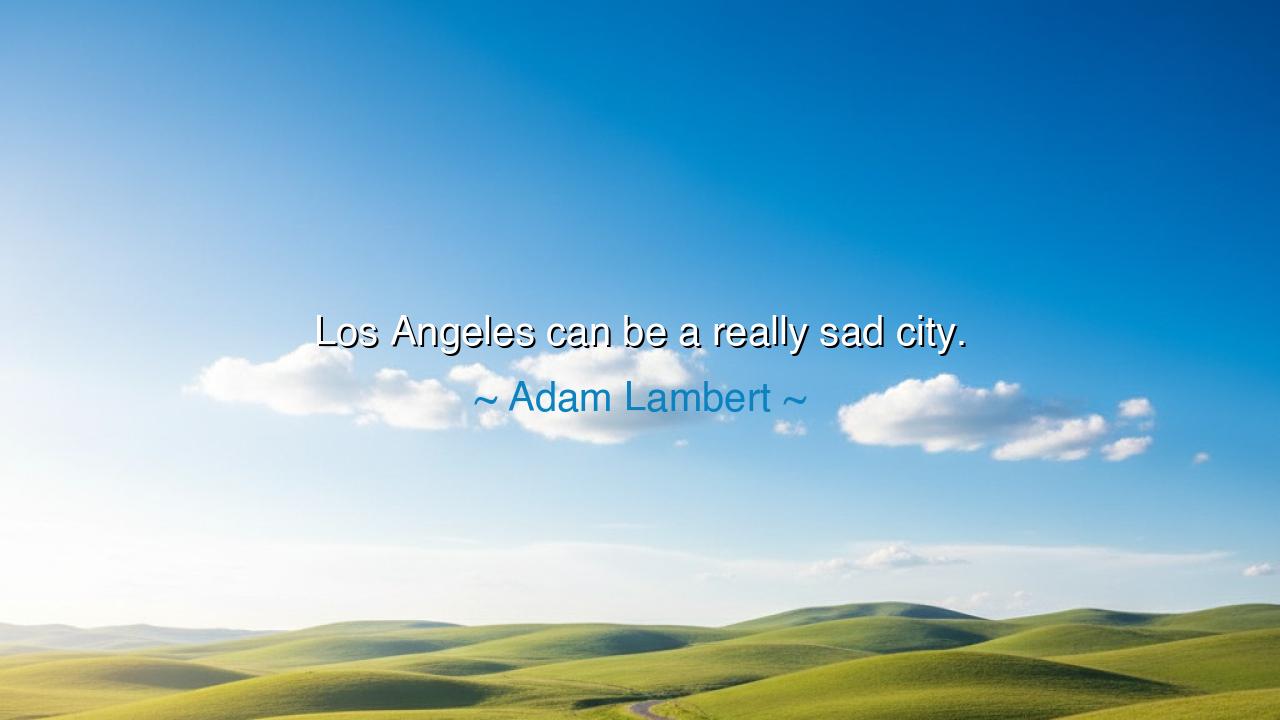
Los Angeles can be a really sad city.






The words of Adam Lambert, “Los Angeles can be a really sad city,” carry a quiet ache beneath their simplicity. They are the lament of one who has looked beyond the glitter of the lights and seen the loneliness that hides beneath the glamour. Los Angeles, the city of angels, was built on dreams—dreams of beauty, fame, and eternal youth. Yet within its shining towers and golden sunsets lies a truth as old as mankind itself: that where there is great desire, there is also great sorrow. Lambert’s words are not a condemnation, but a confession—a recognition that the same place that births hope also breeds emptiness, that the light of ambition casts long shadows across the human heart.
In ancient times, the poets spoke of cities like Babylon and Rome with the same mixture of awe and despair. These were places where the world gathered in search of greatness, yet where many souls were lost amid the noise. So too is Los Angeles in our age—a modern Babylon, where millions come chasing a vision of themselves that may never exist. The city seduces with promises of recognition, beauty, and belonging, yet its streets are paved with broken illusions. Lambert, as an artist, knows this truth intimately. He has walked through fame’s bright corridors and felt how fragile they are. In his words, we hear the whisper of one who has seen that success does not always save the soul—sometimes it isolates it.
The sadness of Los Angeles is not born from cruelty, but from illusion. It is the sorrow of a place where everyone is pretending to be more than they are, where smiles are painted, and joy is often rehearsed. The ancients would have called such a city a mirror of vanity—a place where people chase reflections instead of reality. To live there is to walk through a dream that both inspires and exhausts. The city teaches that fame is fleeting, that applause fades, and that without the anchor of inner truth, even paradise can feel hollow. Thus Lambert’s quote is not only about geography—it is about the human condition. Every heart that chases approval instead of purpose will, sooner or later, find itself wandering through its own sad city.
Consider the story of Marilyn Monroe, the eternal symbol of beauty and tragedy. She came to Los Angeles seeking love, light, and art, and for a time, she became the very embodiment of its dreams. Yet beneath the applause, she battled loneliness so deep that even fame could not fill it. Her life was a parable written in gold and sorrow—a reminder that external beauty cannot heal internal emptiness. In her, and in so many others who came to that city of promise, we see the truth of Lambert’s words: that the saddest city is not one without light, but one that blinds the soul with too much of it.
And yet, there is another layer to this sorrow, one that carries its own quiet dignity. For in the sadness of Los Angeles, there is also yearning—the pure, relentless human desire to create, to become, to transcend. Even among the broken dreams, art still blooms. The city’s sadness, then, is not despair but melancholy—the bittersweet recognition that beauty and pain are inseparable. Like the ancient phoenix, Los Angeles dies a little each night in disappointment, only to rise again each morning in hope. Its sadness is the cost of its magic.
To understand Lambert’s insight is to understand that the pursuit of dreams must be tempered with grounding. Ambition is noble, but when it becomes obsession, it drains the spirit. The wise man does not reject the city of dreams; he walks through it with eyes open. He enjoys the light, but he also seeks the quiet spaces between the noise, where truth resides. The artist, the thinker, the dreamer—all must learn this lesson: to create without losing oneself, to rise without forgetting one’s roots, to shine without burning out.
So let this teaching be passed down: every city that promises glory also conceals sorrow, and every heart that chases light must learn to live with its shadow. Do not be deceived by appearances, nor crushed by disillusionment. Instead, seek meaning, not merely attention; connection, not just admiration. For the true “city of angels” is not made of glass and neon, but of souls who have learned to balance their longing with peace. And when you walk through the sadness of such a city, as Lambert has, you will find that its sorrow is not a curse—but a quiet teacher reminding you that joy without truth is as fragile as fame itself.






AAdministratorAdministrator
Welcome, honored guests. Please leave a comment, we will respond soon